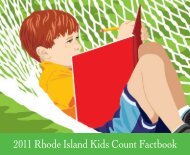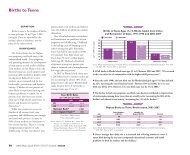2010 Rhode Island Kids Count Factbook
2010 Rhode Island Kids Count Factbook
2010 Rhode Island Kids Count Factbook
Create successful ePaper yourself
Turn your PDF publications into a flip-book with our unique Google optimized e-Paper software.
Permanency for Children in DCYF Care<br />
Subsidized Guardianship, 2009<br />
<strong>Rhode</strong> <strong>Island</strong> Youth Aging Out of Foster Care, FFYs 2000-2009<br />
OUT<br />
YEAR # WHO AGED OUT YEAR # WHO AGED<br />
◆ The federal Fostering Connections Act provides funding for states offering kinship<br />
FFY 2000 82 FFY 2005 103<br />
guardianship assistance payments. <strong>Rhode</strong> <strong>Island</strong>’s guardianship assistance program<br />
FFY 2001 77 FFY 2006 119<br />
defines kin broadly as any adult who has a close and caring relationship with the child,<br />
FFY 2002 62 FFY 2007 145<br />
6% of children in foster care exited care to guardianship, up from 2% in FFY 2005. 22 FFY 2004 82 FFY 2009 151<br />
including godparents, caretakers, close family friends, neighbors, and clergy. 21 In FFY 2009, FFY 2003 85 FFY 2008 157<br />
Total FFY 2000-2004 388 Total FFY 2005-2009 675<br />
Adoptions of Children in DCYF Care, 2009<br />
◆ In calendar year 2009, 278 children in the care of DCYF were adopted in <strong>Rhode</strong><br />
<strong>Island</strong>. Of these children, 60% were White, 21% were Black, 17% were of another race<br />
or were multiracial, and 2% were of unknown race. Twenty-four percent of children<br />
adopted in 2009 were Hispanic (belonging to any race category). 23<br />
◆ Of the children adopted, 62% were under age six, 33% were ages six to 13 and 5%<br />
were ages 14 to 17. 24<br />
<strong>Rhode</strong> <strong>Island</strong> Children Waiting to be Adopted, September 30, 2009<br />
◆ On September 30, 2009, there were 360 <strong>Rhode</strong> <strong>Island</strong> children in the care of DCYF<br />
who were waiting to be adopted, 6% under age one, 22% ages one to five, 31% ages six<br />
to 10, 32% ages 11 to 15, 3% ages 16 and older, and 2% of unknown age. 25<br />
◆ Of all waiting children, 44% were White, non-Hispanic, 27% were Hispanic (of any<br />
race), 17% were Black, non-Hispanic, 9% were two or more races, 1% were Native<br />
American, 2% were Asian, and 1% were of unknown race/ethnicity. 26<br />
Source: Safety, permanency, and well-being in <strong>Rhode</strong> <strong>Island</strong>: Child welfare outcomes annual reports for FY 2000-2009. New<br />
Haven, CT: Prepared by the Consultation Center, Yale University School of Medicine for the Data Analytic Center of<br />
the <strong>Rhode</strong> <strong>Island</strong> Department of Children, Youth & Families.<br />
◆ Between FFY 2005 and FFY 2009, there were 675 <strong>Rhode</strong> <strong>Island</strong> youth who aged out of<br />
foster care with no permanent placement. This was a 74% increase from the previous five<br />
year period when 388 youth aged out of care. 29,30<br />
◆ In FFY 2009, 151 <strong>Rhode</strong> <strong>Island</strong> youth exited out-of-home placement to emancipation,<br />
never having gained permanent placement through reunification, adoption or<br />
guardianship. 31<br />
◆ As of July 1, 2007, youth in <strong>Rhode</strong> <strong>Island</strong> age out of the foster care system at age 18, a<br />
change from age 21 in previous years. Youth with serious emotional disturbances, autism<br />
or a functional developmental disability continue to have their cases managed by DCYF<br />
and remain legally entitled to services through age 21. 32<br />
◆ A recent cost-benefit analysis found that if states extend foster care beyond age 18, an<br />
option that the Fostering Connections Act encourages, the potential benefits in terms of<br />
increased educational attainment, reduced reliance on public assistance and increased<br />
earnings will more than offset the costs to states. 33<br />
◆ Of the 360 children waiting to be adopted, 229 (64%) were children with parents<br />
whose parental rights had been legally terminated. 27<br />
◆ In FFY 2009, 43% of children in the <strong>Rhode</strong> <strong>Island</strong> child welfare system were adopted<br />
within 24 months from the time of removal from their home, down from 49% in FFY<br />
2005 but up from 38% in FFY 2008. The national standard is 32% of adoptions<br />
occurring within 24 months of the child’s removal. 28<br />
References<br />
1<br />
Haskins, R., Wulczyn, F. & Webb, M. B. (2007). Using<br />
high-quality research to improve child. protection<br />
practice: An overview. In R. Haskins, F. Wulczyn &<br />
M. B. Webb (Eds.), Child protection: Using research to<br />
improve policy and practice. (Chapter 1, 1-33).<br />
Washington, DC: The Brookings Institution.<br />
2,8<br />
Mallon, G. P. & Leashore, B. R. (2002). Preface to<br />
special issue: Contemporary issues in permanency<br />
planning. Child Welfare, 81(2), 91-99.<br />
(continued on page 169)<br />
<strong>2010</strong> <strong>Rhode</strong> <strong>Island</strong> KIDS COUNT <strong>Factbook</strong> 109






